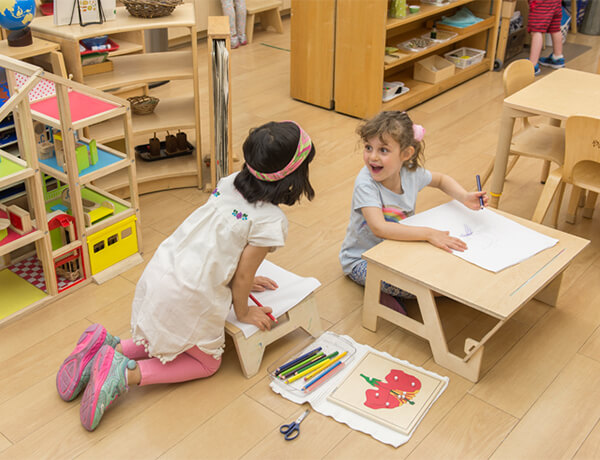Art Area For Preschoolers

Set Up a Safe and Fun Art Area For Preschoolers
Setting up a preschool art area for your preschoolers can be an exciting way to get them excited about exploring their creative potential. With some basic supplies, you can create an inviting and safe environment where your kids can express their imaginations and have fun! In this guide, we’ll cover the basics of setting up a fantastic preschool art area for your preschoolers.
Preschool Art Class Description
The art area is a small world for children to feel, appreciate, express, and create beauty. Children can observe and appreciate different works and objects freely, choose different tools and materials, cooperate with peers in a friendly way, and express their feelings and cognition according to their own wishes and interests, so as to enhance their creativity and aesthetic ability.
You must learn that preschool art space is just as important as a kindergarten classroom. The space needs to be able to accommodate different learning styles and processes when it comes to art projects. There are four learning styles (auditory, visual, physical, and kinesthetic). What works for one might not work for another. When designing an art space for schoolers, the first thing to do is observe how they learn and how you can accommodate each of those four learning styles. So if you’re planning or starting an art class of your own make sure you plan the art space accordingly before you begin painting or building walls.
How to Create an Engaging Art Area for Preschoolers
Creating a preschool art area is a great way to give your little ones an inviting and creative space to explore their artistic side. Follow these preschool art area ideas for toddlers with just five steps, you can have the perfect art center for your kids, complete with supplies and ideas to keep them engaged.
Choose the Right Space
You can use any corner or space in your daycare to create art area activities for preschoolers, but you want to ensure it’s the right size and away from potential hazards. Too big and they won’t feel comfortable. Too small and they won’t have enough room for creativity. Find a place where there is plenty of natural light and plenty of wall space for hanging artwork.
Include a Variety of Creative Materials
Having a variety of art materials available provides children with different options to explore. It opens a world of possibilities for experimentation and design. Include paints, brushes, construction paper, clay, markers, crayons, colored pencils, and more. Ensure the material is safe and age-appropriate. Provide storage containers to keep everything organized and accessible.
Organize Your Art Space in a Fun and Efficient Way
What to put in a preschool art center. Providing storage containers for the art supplies helps children stay organized and makes it easy to access the items. Have a dedicated space in your preschool that’s designated just for the materials, so everything is easy to find. Put drawers or bins close by that can be easily accessed when needed without having to disturb other areas of the room. Labeling the containers will make it even easier for kids to know where particular items are stored.
Make Safety a Priority when Choosing Materials & Furniture
Safety should be your main priority when setting up your art space. All materials and furniture need to be non-toxic, lead-free, and designed with safety in mind. Ensure that the items used around the room are appropriate for young children and that any sharp edges are covered or otherwise made safe from potential harm. Additionally, use anti-slip mats underneath tables to prevent kids from slipping and falling near paint supplies or art easels.
Incorporate Plenty of Storage Solutions for Easy Cleanup
Once you’ve assembled the essential pieces for your preschool art space, providing enough storage and organization solutions for easy cleanup is important! Plastic drawers underneath tables are the best option for tidying up supplies quickly and efficiently. You can also use peg boards with hooks to hang brushes or crayons, as well as adjustable wall shelves to store paints and clay trays. Utilizing plenty of storage solutions will keep your space open yet organized when it comes time to clean up — a major help when working with preschoolers!
Conclusion
Ultimately, it’s important for designers to understand how important art classes are for school-aged kids. It’s about more than just designing a pretty space, or creating a safe environment for budding artists. It’s about making sure kids have the opportunity to express themselves and develop their creativity, regardless of whether they’re artists in the making or not. And while it may not be our job to foster or develop this creativity, it is up to us to create an environment where it can flourish.

